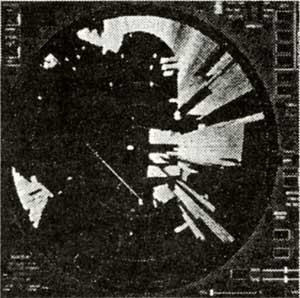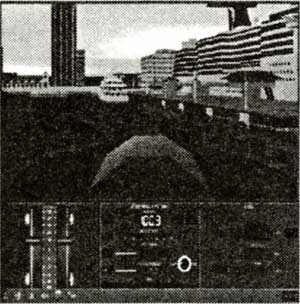|
SCALABLE SIMULATION FOR BRIDGE OFFICER TRAINING
Garland Hardy (LANTEC Marine Inc., Canada)
Herbert F. Taylor (Kongsberg Maritime Ship Systems, USA)
Abstract: The objective of this paper is to highlight the Canadian Navy's progressive development of a scalable simulation training system as the primary tool to support all of its requirements for bridge officer training, from cadets to the ships' captains. It will discuss how the addition of a suite of part task trainers, using a simulation engine common to the Navy's established full mission simulators, has afforded the advantage of compatibility of databases, models and training scenarios. Additionally, it will explain how this new capability has enhanced the accessibility and flexibility of simulation training for bridge officers, hence facilitating the blending of the training process with ship's operational/officer's career cycles to capitalize on experience gained at sea; and more importantly, the inverse.
On the topic of part task trainers the paper will focus on their use primarily in developing individual skill sets both in single and limited multitask environments. There will be discussions on the balance of self-study versus instructor-assisted training, distributed versus centralized training programs, and evaluation tools and student progress tracked through a learning management system.
Finally, the paper will address how simulation-based training has been optimised to suit a bridge officer's overall career training needs at various rank and experience levels, how its various training programs can be easily adapted to suit specific performance standards, and the progress to date of applying the results from the program to simulator training programs in other organizations.
1. INTRODUCTION
The effectiveness of any production process can ultimately be measured only by the quality of the end product that it generates. A successful system for Naval Bridge Officer training must, over the long term, provide the structure necessary to effectively produce talented warship Captains. In order to fulfil this mandate, the Navy requires a total training system that meets all of its practical instruction demands.
In the early 1990's, the Canadian Naval Fleet underwent a metamorphosis. The steam destroyers that had formed the mainstay of the fleet were gradually de-commissioned, replaced by twelve City Class Frigates, and twelve Maritime Coastal Defence Vessels (MCDVs). The dedicated training squadron, comprised of four ageing Destroyer Escorts (DDEs) and five former minesweepers, was slowly disbanded. Additionally, the MCDVs were crewed exclusively by Naval Reservists; a sharp contrast from previous manning policies in operational vessels. The loss of training platforms, the contraction of training budgets, and to a lesser degree the shift in the role of the Naval Reservist, initiated the requirement for the Navy to find an alternative means to deliver practical bridge-manship training.
Fig. 1: Fleet transformation.
The objective of this paper is to highlight the Canadian Navy's progressive development of a scalable simulation training system as the primary tool to support all of its requirements for practical bridge officer training.
2. DEBUT OF HIGH FIDELITY SIMULATION TRAINING
In 1994, the Canadian Navy embarked on a programme to essentially replace the practical training venues that would be lost when the last of the training vessels were de-commissioned. The first step in this process was taken in 1995 when the Navy contracted Kongsberg Maritime Ship Systems (formerly Norcontrol Systems) to deliver two bridge simulators. The first simulator, consisting of one full mission bridge (FMS) and three blind pilotage bridges was installed at the Naval Operations School Halifax in August 1995. The role of the Halifax simulator was to provide bridge-manship training at advanced career coursing levels and to support Atlantic Fleet continuation training and skill maintenance.
Figure 2: FMS Facilities.
The second simulator, consisting of four FMS bridges and four blind pilotage bridges was installed at the newly constructed Naval Officer Training Centre (NOTC) Esquimalt in the fall of 1997. The Esquimalt simulator was to be used as the delivery vehicle for all initial bridge officer training and to support Pacific Fleet continuation training and skill maintenance. The newly established Naval Reserve Fleet School in Quebec City had no bridge simulation capability.
3. TRAINING CHALLENGES IN A SIMULATED ENVIRONMENT
With the transfer of the instruction of practical skill sets to the simulator environment, the Navy faced the challenge of accomplishing its training objectives using five FMS bridges and seven radar bridges versus five minesweepers and four DDEs. In many respects, the simulator environment provided a very efficient and enhanced training medium where instructors had complete control over situational variables and directed training elements. There were, however, several areas where the Navy could not fully achieve all of its practical training objectives with only five FMS bridges.
3.1 Independent Study and Development
In an effort to meet their mandated training objectives, the four FMS bridges at the Officer Training Centre were used at near capacity and taxed instructional staff to their fullest. The lack of additional simulator time and instructor availability dictated that there was no opportunity for a cadet to work independently to further develop or consolidate recently instructed practical skill sets. In the shipboard training environment, this was accomplished by standing night watches in an "on the job" environment, under the supervision of a ship's officer.
3.2 Instruction of Basic Skills
Entry-level training requires that the students get "hands on time" to complete relatively simple, single tasks while their performance is being continuously monitored. At the early stages of cadet training, the Navy had no option but to use the FMS to conduct this single task and basic practical training. This approach implied an under-utilisation of expensive resource capability and dictated a low student to teacher ratio for simple instructional tasks. Increases in recruiting, particularly for the Naval Reserve component, placed higher than anticipated demands on the four FMS at the Naval Officer Training Centre and further aggravated this problem, limiting the availability of the resource for important and more task suited fleet training.
3.3 Mentorship
The instructional staff at the Naval Officer Training Centre consists primarily of Lieutenants with three to five years seniority. These officers have good skill sets and experience as an Officer of the Watch (OOW), but do not generally provide the same experience and mentoring previously offered to the cadets by the Captains of the training minesweepers and DDEs. As a consequence, students did not always receive a good sense of context as to why procedures were conducted in a particular fashion. Additionally, the mentorship provided tended to be much less consistent than if it was originating from a more experienced officer.
3.4 Practical Training: Naval Reserve Divisions
The Naval Reserve still needed a practical mechanism to maintain perishable skill sets within its officer corps. In order to meet the challenge of supporting the new requirement to crew 12 minor warships exclusively with Naval Reservist, the Navy required a means to provide skill maintenance or continuation training, at 21 geographically dispersed Reserve Divisions.
4. COMPLETING THE SCALABLE TRAINING SYSTEM - FUNCTIONAL REQUIREMENTS
Faced with the previously mentioned difficulties related to a practical training system anchored around five FMS bridges, and a fairly limited amount of financial resources, the navy sought out a single source, technical solution to a diverse and de-centralised training problem. In order to augment the current FMS based training in a cost effective manner, it was deemed that the Navy required a training tool to address the following major requirements:
- capitalise on the considerable investment in area training databases, ship hydrodynamic models, and training scenarios developed for the FMS;
- support a level of simulation fidelity, in the single or part task training environment, parallel to that of a FMS in order to offload single and part task instruction from that tool, particularly at the cadet level of instruction;
- provide some sort of mentoring or electronic coaching mechanism which could support self study and provide meaningful monitoring to a student in the absence of a "Live" instructor;
- be equipped with a Learning Management System that could monitor student and class usage rates, individual and group progression, and that would facilitate curriculum management;
- require minimum infrastructure support both with respect to instructional staff and equipment maintenance; and
- be scalable and configurable to meet a broad range of centralised and de-centralised training requirements and skill levels.
5. PART TASK TRAINER SELECTION
The Canadian Navy considered several types of technology to meet their needs for a Part Task Trainer ranging from virtual reality systems to PC based simulators. In September 2001, they entered into the contract with KMSS, the manufacturer of their FMS systems, for the delivery of 63 PC based part task simulators running their Polaris Desktop software. The Canadian Navy Part Task Trainer (NPTT) supports high fidelity simulation of ship hydrodynamics, visual scenery, and RADAR/ECDIS functionality. The NPTT utilises the same simulation engine as the FMS running from conventional PCs with a Windows 2000 operating system. It employs a flexible network configuration, and makes use of emulated panels to replicate the functionality of various pieces of bridge equipment and controls. To meet unique aspects of the Navy's training requirements, an exact reproduction of the Kingston Class steering control system and the Kingston and Halifax Class ARPA systems have been emulated with the remainder of instruments being mirror images of the FMS generic instrumentation panels. For specific training applications, select NPTTs have been configured to stimulate real equipment. Additionally, the capabilities of the Polaris Desktop Student Evaluation System have been expanded to meet the Navy's needs for an electronic coaching tool and a self-study simulation capability.
6. RECONFIGURATION: ADAPTING TO DIVERSE TRAINING NEEDS
In order to provide an effective medium for the broad range of instructional applications required to complete the Navy's scalable bridge officer training system, the NPPT student workstation layout can be easily reconfigured. One computer monitor serves to alternately display radar (choice of two ARPA displays, ship model dependant) or ECDIS. The second computer screen is divided into nine segments and can be customised to display any combination of available panels in any position and with variable sizes. If an instructor is using the NPTT to project a rule of the road situation, he/she may elect to simply display the radar picture on the left and the visual scene with a true bearing marker on the right. Self-study exercises will load specific, default panel configurations dependant upon task requirements. Additionally, the student is able to activate or resize any panel, as he/she deems appropriate to changing exercise conditions. This arrangement provides the instructor_ and student with an effective means of regulating the amount and type of information and stimuli that are used for any given single task or part task training scenario.
Figure 3: NPTT Screen Layout - Docking.


Self-study exercises have been compiled with varying degrees of complexity to address any experience level. Self-study exercises also vary in nature from illustrative and instructional to evaluative. The role of the e-coach and student evaluation tools would in this case vary accordingly. A basic level exercise designed to teach radar operations and functions would not require the student to con the ship, navigate or conduct anti-collision functions. In this situation, the e-coach would advise the student on the function of the various radar controls. In contrast, an advanced exercise designed as an examination of a particular skill set such as coastal navigation in restricted visibility would require the student to con his ship, plot its position, and use all available tools including ARPA to assess anti-collision situations. The e-coach would not provide guidance but would merely correct inappropriate behaviour; and the student evaluation system would score the student based on his/her actions.
Figure 4: E-Coach Pop Up Windows.
The majority of the 40 exercises delivered with the NPTT cater to the identified shortfalls in cadet training. Over the course of 2003, the Navy will expand this library to include supplementary training for advance coursing conducted at the Reserve Fleet School and the Naval Operations School, as well as the development of a training programme for candidates preparing to challenge the command endorsement board.
|